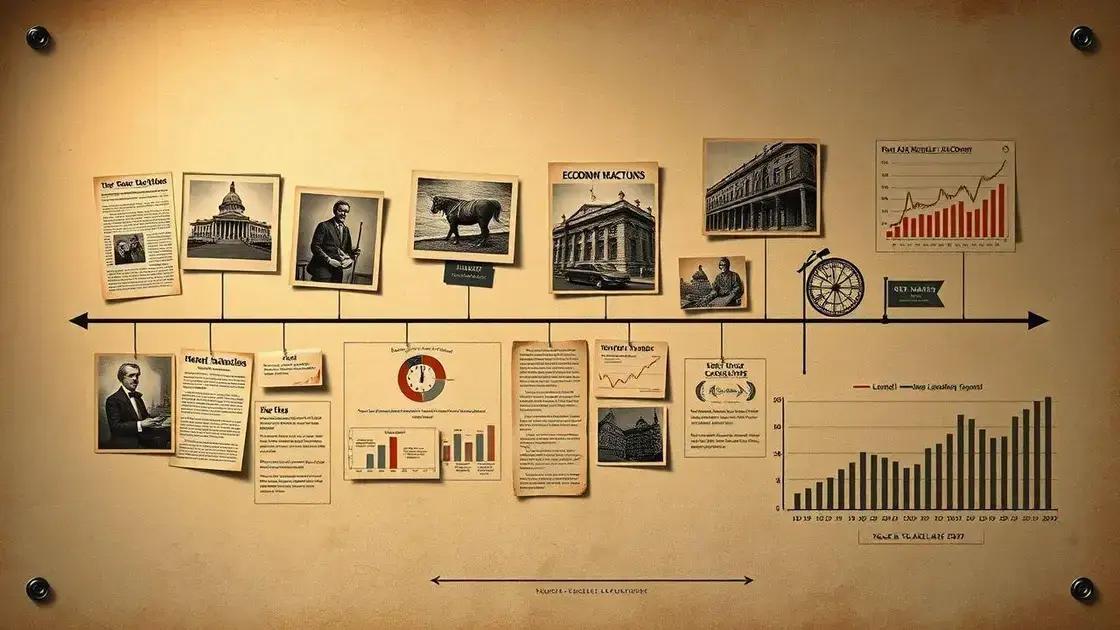Economic contraction Q1 2025: what to expect

Anúncios
Economic contraction refers to a decline in national output, often caused by factors like financial crises, high inflation, and global events, leading to reduced consumer spending and increased unemployment rates.
Economic contraction Q1 2025 is on the horizon, prompting many to wonder how it might affect their financial landscape. This period of decline could influence everything from job security to investment strategies. Are you prepared for what’s coming?
Anúncios
Understanding economic contraction
Understanding economic contraction is crucial as it helps us navigate the complexities of financial systems. Economic contraction refers to a decline in national output, typically measured by gross domestic product (GDP). This phenomenon can happen for various reasons, and recognizing the signs early can aid in mitigating negative impacts.
What Causes Economic Contraction?
Several factors can trigger an economic contraction, including:
Anúncios
- High inflation rates that erode purchasing power
- Decreased consumer confidence leading to lower spending
- Supply chain disruptions that affect production
- Increased interest rates that discourage borrowing
Each of these factors can contribute to a decline in economic activity. For instance, high inflation can cause consumers to tighten their budgets, resulting in lower demand for goods and services. Similarly, when interest rates rise, businesses may delay expansion plans.
Indicators of Economic Contraction
Identifying the signs of economic contraction is vital for businesses and individuals alike. Some key indicators include:
- Rising unemployment rates, reflecting layoffs and hiring freezes
- Declining retail sales as consumers cut back
- Slowing manufacturing output indicated by reduced factory orders
These indicators provide insights into the economic climate. By monitoring them closely, stakeholders can make informed decisions to safeguard their finances.
Moreover, understanding economic contraction empowers consumers and businesses to prepare for potential challenges. During such periods, adapting strategies and managing resources effectively can be crucial for survival.
Indicators of economic slowdown
Indicators of economic slowdown are essential for understanding how the economy is performing. Recognizing these signs early can help businesses and individuals adapt their strategies. Various factors contribute to a slowdown, and identifying them can help in planning for the future.
Key Economic Indicators
Some vital indicators to watch for include:
- Unemployment rates: A rise in unemployment often signals economic trouble. It indicates that companies are laying off workers and are not hiring.
- Retail sales: When sales begin to decline, it can show that consumers are spending less. This change could be due to reduced income or uncertainty.
- Manufacturing output: A decrease in production can signal that demand is weakening, leading companies to scale back. This might reflect a broader economic trend.
Each of these indicators provides a snapshot of the economy’s health. For example, when retail sales fall sharply, it often leads to reduced confidence among producers, who may then cut back on their workforce.
Consumer Confidence Index
The Consumer Confidence Index (CCI) is another essential indicator. When consumers feel optimistic, they are more likely to spend money. Conversely, a drop in the CCI often foreshadows a slowdown.
Monitoring these indicators allows businesses to react proactively. Strategies such as adjusting inventory or pausing expansion can help mitigate losses. Furthermore, consumers can also prepare for potential changes in their financial situations by tracking these signs.
Understanding the indicators of economic slowdown can empower individuals and businesses to make better decisions. By being aware of the economic landscape, one can take action to protect their finances and investments.
Impact on employment rates
The impact on employment rates during an economic contraction is significant. As businesses face declining sales and profits, they often have to make difficult decisions, including reducing their workforce. Understanding these changes helps individuals and communities adapt to challenging economic times.
How Economic Contraction Affects Jobs
During periods of slow economic growth, the job market can shrink. Companies may implement measures to cut costs. This often results in:
- Layoffs: Businesses may let go of employees to reduce payroll expenses.
- Hiring freezes: Companies may stop hiring new workers, which prevents job openings.
- Reduction in hours: Workers may have their hours cut, leading to reduced income.
These factors collectively lead to higher unemployment rates. When layoffs occur, it further increases the number of people seeking jobs, making competition fiercer.
Long-term Consequences
The effects of an economic downturn on employment can be long-lasting. It may take time for the job market to recover after the contraction ends. Workers who have lost jobs might need to re-skill or up-skill to meet the demands of a changing economy.
Furthermore, long-term unemployment can have psychological effects on individuals. It can lead to decreased morale and motivation, making it even harder for them to return to work.
Staying aware of the impacts on employment rates during economic downturns helps individuals prepare for the future. By tracking these changes, workers can explore new opportunities or adjust their career paths accordingly.
Effects on consumer spending

The effects on consumer spending during an economic contraction are profound. As the economy slows, consumers tend to change their spending habits significantly. Understanding these changes is crucial for businesses and policymakers.
Spending Habits Shift
When faced with economic uncertainty, consumers often prioritize essential items over luxury goods. This shift results in:
- Decreased discretionary spending: Items like electronics, vacations, and dining out are often cut from budgets.
- Increased savings: Many consumers begin saving money for emergencies, leading to lower spending rates.
- Focus on essentials: Spending is redirected towards necessary goods such as food and healthcare.
This change in behavior can lead to decreased revenues for many businesses, especially those in retail and hospitality. As consumer confidence declines, companies may struggle to meet their financial goals.
Long-term Implications
The long-term effects of reduced consumer spending can also impact economic recovery. If consumers remain cautious about their spending habits, businesses may have a harder time rebounding once the economy begins to recover.
Moreover, continuous tight consumer spending can slow down job creation. Companies may hesitate to hire or could even lay off employees in anticipation of poor sales. Tracking these spending patterns is vital for businesses to adjust their strategies accordingly.
Ultimately, understanding the effects of economic contraction on consumer spending allows individuals to make informed financial decisions. By preparing for potential changes, consumers can navigate challenging economic landscapes more effectively.
Strategies for businesses
During an economic contraction, businesses must adopt effective strategies to navigate challenges. Understanding these strategies can help companies maintain stability and position themselves for recovery. Emphasizing resilience and adaptability is vital for survival in tough economic times.
Cost Management
One of the primary strategies is managing costs effectively. Companies can:
- Reduce overhead: Evaluate fixed and variable costs to find areas for savings.
- Streamline operations: Optimize processes to increase efficiency while cutting waste.
- Negotiate with suppliers: Work to lower prices or extend payment terms to improve cash flow.
By focusing on these areas, businesses can free up capital and retain essential resources during downturns.
Enhancing Customer Engagement
Another critical strategy is enhancing customer engagement. Staying connected with customers helps retain loyalty even when spending is tight. To achieve this, businesses can:
- Offer loyalty programs: Reward returning customers to encourage continued patronage.
- Utilize social media: Engage customers online to foster community and keep them informed.
- Gather feedback: Use surveys to understand customer needs and adapt offerings accordingly.
Being responsive to customer feedback can improve satisfaction and drive repeat business. During economic contractions, maintaining relationships is more important than ever.
Exploring new revenue streams also becomes vital in uncertain times. Businesses may consider:
- Diversifying product lines: Introducing new products to attract different customer segments.
- Expanding to new markets: Exploring unexplored demographics or geographic areas.
- Leveraging technology: Adopting e-commerce solutions or digital marketing to reach broader audiences.
Implementing these strategies allows businesses to adapt to changing conditions. By focusing on both cost management and customer engagement, companies can weather the storm of economic contraction while laying the groundwork for future growth.
Global implications of contraction
The global implications of economic contraction extend far beyond the borders of any single nation. As countries face declining economic growth, the effects can ripple through international markets and influence worldwide economic dynamics. Understanding these global ramifications is essential for policymakers and businesses.
Impact on International Trade
One of the primary global implications is the effect on international trade. Economic contractions often lead to:
- Reduced demand for imports: Countries facing economic declines may buy fewer goods and services from abroad, impacting exporting nations.
- Supply chain disruptions: Economic issues can cause delays or shortages in the supply chain, affecting businesses worldwide.
- Trade barriers: Countries may respond to economic challenges by increasing tariffs or implementing protectionist measures, further hindering global trade.
As trade slows, it can lead to increased tensions between nations and affect diplomatic relationships.
Effects on Investment
Economic contraction often leads to decreased investor confidence. This shift can have global consequences, such as:
- Reduced foreign direct investment: Investors may hesitate to commit capital in uncertain markets.
- Volatility in financial markets: Stock and currency prices can fluctuate wildly during times of economic uncertainty, leading to global market instability.
- Withdrawal of multinational corporations: Companies may close operations in struggling markets or shift resources to more stable economies.
These factors can hinder economic recovery efforts and prolong downturns across the globe. As investments decrease, job growth halts, affecting employment rates worldwide.
In addition, economic contraction can drive countries to rely more heavily on international aid and support, especially developing nations. This reliance can create dependency, further complicating the global economic landscape.
By examining the global implications of economic contraction, nations can better understand the interconnectedness of their economies. This awareness can lead to more cooperative approaches to tackling economic challenges and fostering growth.
How to prepare for downturns
Preparing for economic downturns is essential for individuals and businesses alike. Being proactive can help mitigate risks and ensure stability during challenging times. Understanding effective preparation strategies is vital to weather any financial storm.
Build a Financial Safety Net
One critical step in preparing is creating a financial safety net. This involves:
- Establishing an emergency fund: Aim to save at least three to six months of living expenses. This fund can help cover essential costs during periods of reduced income.
- Reducing debt: Pay down high-interest debts to lower monthly expenses and free up money for savings.
- Reviewing insurance policies: Ensure adequate coverage for health, property, and income loss, providing protection during difficult times.
These financial foundations can improve resilience against economic shocks.
Diversify Income Streams
Another effective strategy is to diversify income sources. This can include:
- Starting a side business: Explore passions or skills to generate additional income.
- Investing wisely: Consider various investment options to spread risk, including stocks, bonds, and real estate.
- Freelancing or gig work: Utilize skills to take on freelance projects or part-time work, helping to supplement income during downturns.
Diversifying income can provide a buffer when primary income sources face challenges.
Additionally, staying informed about economic trends is crucial. Regularly monitor market changes and economic indicators to anticipate possible downturns. Understanding how these factors can impact personal finances or business operations allows for quicker adaptations.
Engagement in continuous learning also prepares individuals for changes in the job market. Developing new skills can increase employability and adaptability, making it easier to find opportunities during downturns. Resources like online courses or workshops can be helpful in this regard.
By taking these steps, individuals and businesses can better prepare for economic downturns. Adopting a proactive mindset fosters resilience and helps navigate uncertain economic landscapes more effectively.
Lessons from past contractions

Lessons from past economic contractions provide valuable insights that can help individuals and businesses prepare for future downturns. Analyzing historical data allows us to understand the impacts of recessions and what strategies worked best during those times.
Understanding the Causes
One key lesson involves understanding the causes of past contractions. Common triggers include:
- Financial crises: Events like the 2008 financial crisis were due to housing market collapses, showing the risk of unsustainable lending practices.
- Global events: Situations such as pandemics or geopolitical tensions often affect economic stability. For example, the COVID-19 pandemic led to widespread business closures and supply chain disruptions.
- High inflation: Situations where prices rise too quickly can lead to decreased consumer spending, as seen during the 1970s stagflation.
Recognizing these causes can guide policy changes and corporate strategies to avoid similar pitfalls in the future.
Adaptability is Crucial
Another crucial takeaway is the importance of adaptability. During past contractions, businesses that quickly adjusted their models to meet changing consumer needs often fared better. Examples include:
- Pivoting products: Companies shifted their production lines to provide essential goods, like distilleries producing hand sanitizer during the pandemic.
- Emphasizing digital solutions: Businesses that embraced e-commerce or remote work were able to maintain operations when physical locations had to close.
- Improving customer engagement: Companies that communicated frequently and clearly with their customers were more likely to retain loyalty during difficult times.
Adaptability is vital for survival during challenging economic periods. Implementing flexible strategies can help businesses pivot in response to changing market conditions.
Lastly, building strong financial reserves emerged as a common theme. Companies that entered recessions with robust cash flow or emergency funds managed to sustain operations while others struggled. This lesson emphasizes the importance of maintaining financial health during prosperous times to cushion the impacts of future downturns.
By studying the lessons from past economic contractions, individuals and businesses can develop more effective strategies for resilience and recovery in challenging economic environments.
FAQ – Questions About Economic Contraction and Preparation Strategies
What are the main causes of economic contraction?
Common causes include financial crises, global events like pandemics, and high inflation rates, which can negatively impact economic stability.
How can individuals prepare for economic downturns?
Individuals can prepare by building a financial safety net, reducing debt, diversifying income streams, and staying informed about economic trends.
Why is adaptability important during an economic contraction?
Adaptability allows businesses and individuals to adjust quickly to changing market conditions, helping them survive and thrive during challenging times.
What lessons can be learned from past economic contractions?
Key lessons include the importance of understanding economic causes, maintaining financial reserves, and effectively engaging with customers to retain loyalty.






